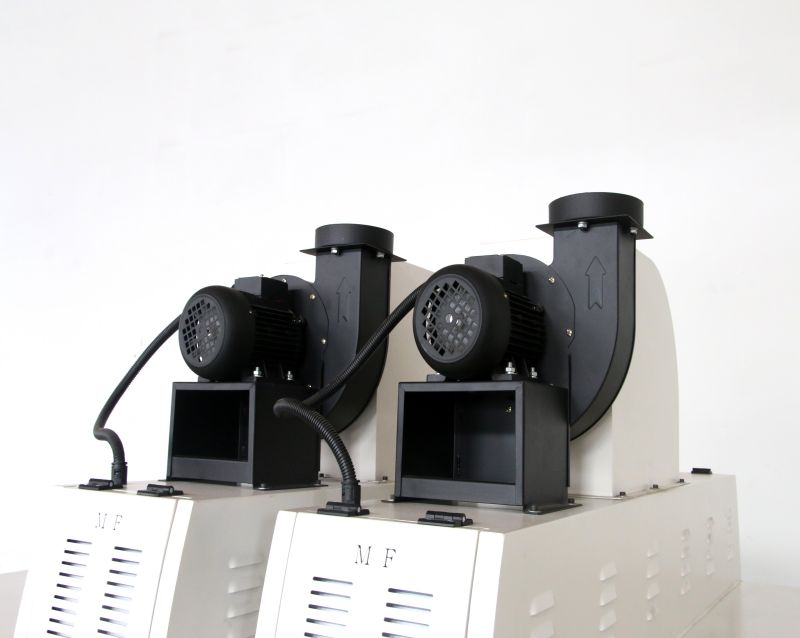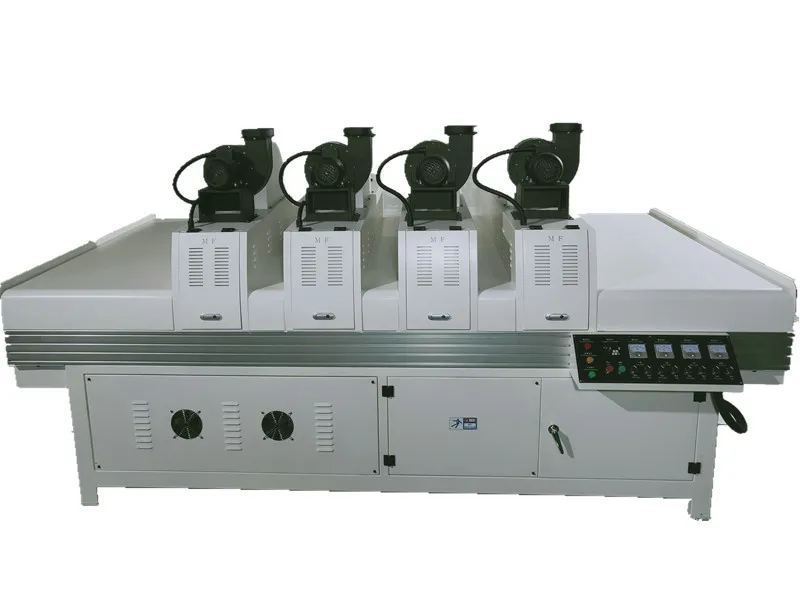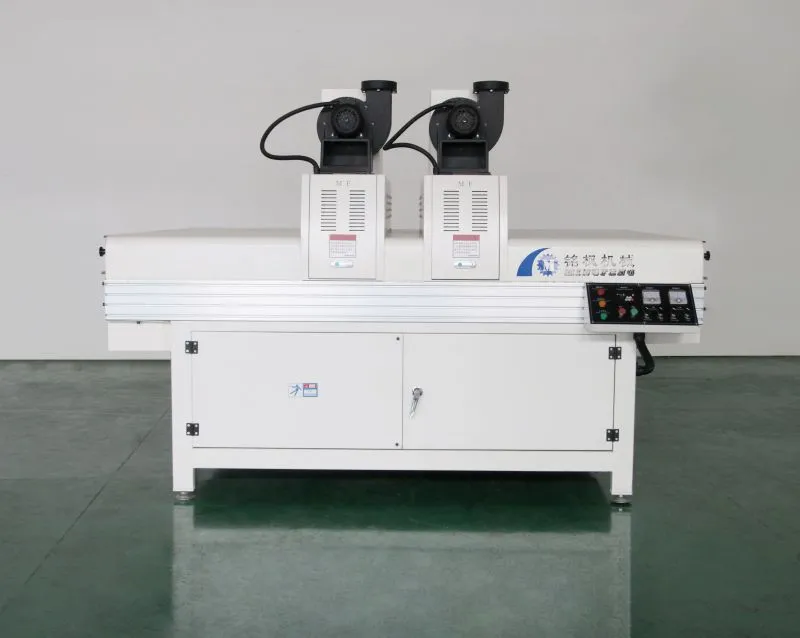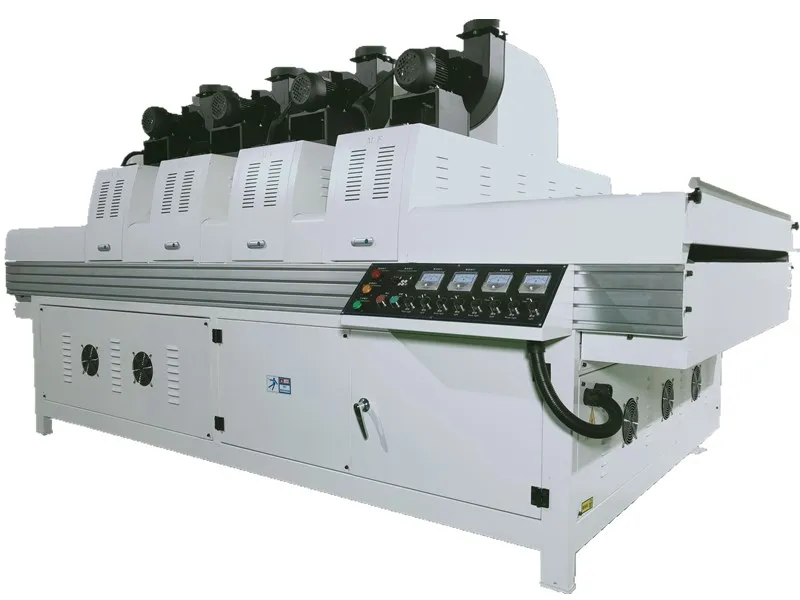This is a very common and practical question in wood coating and production lines. With the right formulation and process, a wood UV drying machine (equipment used for UV curing) can generally make paint "dry" faster—effectively, it cures the film faster.
However, to correctly apply this conclusion in production practice, it's necessary to understand why it's faster, under what conditions it's effective, what the limitations and potential problems are, and how to ensure quality through process control. Below, I'll break down these issues using a technical and systematic approach.
Understanding the Meaning of "Dry": Drying vs. Curing
The term "fast-drying paint" has two technical meanings:
• Physical drying: Traditional solvent-based or water-based coatings rely on the evaporation of solvents or water. Surface drying requires waiting for solvent migration and evaporation; full curing (hardening) may take even longer.
• Chemical curing: UV systems use photoinitiators to chemically cross-link monomers/oligomers into an insoluble, infusible three-dimensional network. Curing times are measured in milliseconds to seconds and are independent of solvent evaporation.
Wood UV Drying Machines primarily rely on light-triggered curing, significantly reducing film-forming time when using UV-curable coatings. This is the source of their speed advantage. However, not all wood coatings are compatible with UV-curable systems; formulation and equipment coordination are required.

Wood UV Drying Machines: Why Do They Dry So Fast?
• Light energy instantly triggers a chemical reaction: UV light is absorbed by the photoinitiator, immediately generating free radicals or photoacids, which then undergo polymerization/crosslinking. The chemical reaction can be completed in milliseconds to seconds.
• Evaporation-independent: The film-forming process does not require waiting for solvent evaporation or diffusion, thus eliminating the drying window.
• High power output and short dose time: Modern UV lamps (such as medium-pressure mercury lamps or LED UV) deliver high-intensity radiation over a short distance, providing sufficient energy dose (dose = intensity × time) for complete curing.
• Enables immediate processability: Rapid curing significantly reduces waiting time for subsequent processes (such as sanding, lamination, and assembly). These fundamentals explain why, with the right formulation and equipment, a UV Wood Drying Machine can achieve very short film-forming times.
What Factors Affect the Drying Speed of a UV Wood Drying Machine?
Whether a UV Wood Drying Machine can significantly accelerate film formation depends on several interrelated factors:
1. Coating Formulation (Most Critical)
• UV-Curable System: Only UV-curable systems or those containing UV-activated photoinitiator systems can achieve rapid curing. Traditional (non-UV) paints cannot be "dried" to film-forming in a UV dryer alone.
• Photoinitiator Selection and Concentration: The photoinitiator must match the wavelength of the light source used (broad-spectrum mercury lamps vs. narrow-spectrum LEDs; different initiators are wavelength-sensitive).
• Monomer/Polymer Type and Functional Monomer Content: The higher the double bond content and the more reactive, the faster the crosslinking rate.
• Pigments and Opacity: High-hiding pigments (such as high amounts of titanium dioxide) can block UV penetration, hindering deep-layer cure and requiring higher dosages or layered coatings.
2. Film Thickness
• UV curing is suitable for thin films (typically a few μm to tens of μm). Thinner films cure more thoroughly and faster; thicker films require higher energy or multi-layer curing.
3. Light Source Type and Parameters
• Light Source Type: Traditional medium-pressure mercury lamps emit a broad spectrum of UV light with strong penetration; LED UV uses a narrow spectrum but has less thermal impact.
• Irradiance: Measured in mW/cm²; higher irradiance means more conversion per unit time.
• Dose: Measured in J/cm² (dose = intensity × time). Achieving the minimum curing dose specified for the coating will result in complete cure.
Example (illustrative): If the lamp intensity is 1000 mW/cm² and the exposure time is 1 second, the dose is 1 J/cm²; different formulations may require doses ranging from 0.5–5 J/cm² (depending on the formulation and film thickness).
4. Oxygen Inhibition and Inert Gases
• Free radical curing is inhibited by oxygen, resulting in a "sticky" layer on the surface. This can be addressed by increasing the dose, shortening the exposure distance, or using nitrogen inerting.
5. Substrate and Wood Properties
• Wood Moisture Absorption and Moisture Content: Highly humid wood can affect coating adhesion and appearance; UV curing does not remove moisture from the wood, so moisture content must be controlled before coating.
• Wood Heat Sensitivity and Discoloration: High-intensity light and heat can cause discoloration or warping in some wood types. Low-heat light sources (such as LEDs) or cooling are necessary.
6. Process Design (Conveyor Speed, Light Box Length, Cooling)
• Line speed and exposure zone length determine exposure time; equipment design must ensure each workpiece receives the required dose while maintaining adequate heat dissipation.

Wood UV Drying Machine Compared to Traditional Drying Methods: Speed Comparison
• Traditional hot air/oven (relying on temperature to accelerate solvent evaporation): Typically takes minutes to several hours (depending on coating type, film thickness, and drying temperature). Complete curing may take longer.
• Infrared Drying/Hot Air Synergy (accelerated surface evaporation): Faster than pure hot air, but still primarily based on evaporation.
• UV Curing (Wood UV Drying Machine): When using UV-curable coatings, surface curing can be completed in milliseconds to seconds, allowing immediate handling or further processing.
Thus, from a per-piece processing time perspective, a Wood UV Drying Machine, when paired with UV coatings, can significantly reduce line time.
Why aren't all wood coatings directly accelerated using a Wood UV Drying Machine?
Key limitations include:
• Coating Type Restrictions: Many traditional wood finishes are solvent-based or water-based, non-UV resins. These do not contain UV-sensitive crosslinking systems and cannot be cured by UV exposure instead of evaporation or heat. UV drying machines must be used with UV-curable coatings or compatible hybrid systems.
• Pigment and Hiding Issues: High-hiding formulations can block UV penetration, resulting in incomplete curing of base layers or thick films.
• Thick/Multi-layer Systems Require Layered Curing: Thick coatings often require thin coatings, curing, and then re-spraying. Otherwise, the surface will cure while the underlying layers remain uncured.
• Wood moisture content and volatiles: If the substrate contains water or requires solvent removal, UV will not replace these processes.
• Equipment compatibility and safety: UV equipment selection, cooling, ozone treatment (mercury lamps), and operational safety must all be in place.
Thus, to determine whether it can be "faster," the first consideration is whether the process has been switched to a UV-curable system.

Wood UV Drying Machine: Implementation Issues and Prevention Recommendations
1. Common Problems
• Surface stickiness or uncured surface (oxygen inhibition or insufficient dosage)
• Surface yellowing or color shift (improper light source wavelength, thermal effects, or formulation)
• Deformation or heat damage (insufficient light box heat dissipation or excessive lamp power)
• Deep uncured layers (film thickness or pigment obstruction)
• Viscosity fluctuations leading to uneven spraying (coating compatibility issues)
2. Key Prevention and Control Points
• Select the right coating and photoinitiator: The photoinitiator must match the light source wavelength. If using an LED light source, select an initiator that absorbs efficiently at that wavelength.
• Control film thickness and spray in layers: A thin-layer, multiple-pass strategy is a common method for ensuring uniform curing.
• Set appropriate irradiation dose: Use a measuring instrument to calibrate the actual irradiation intensity, and set the delivery speed to achieve the target dose at each location.
• Consider inerting (nitrogen) to eliminate oxygen inhibition: This is particularly necessary for high-gloss or tack-free finishes.
• Use low-heat LEDs and maintain effective cooling: This reduces thermal impact and discoloration on the wood.
• Strictly control wood moisture content and pre-treatment: Ensure the substrate is stable and moisture content is within the specified range before spraying.
• Establish quality assessment methods: Methods such as MEK wipe tests, surface tack tests, hardness tests, and adhesion tests are used to assess cure quality.
Wood UV Drying Machine: Safety, environmental protection, and equipment maintenance
• Ozone and mercury lamp issues: Medium-pressure mercury lamps may produce ozone and contain mercury, requiring ozone purification and waste lamp recycling; LEDs do not pose ozone issues.
• UV exposure risk: Complete shielding, protective interlocks, and operating procedures must be implemented to prevent direct exposure.
• Lamp aging and output degradation: Both mercury lamps and LEDs degrade over time and must be replaced according to their lifespan. Reflectors must be kept clean to avoid insufficient dosage, resulting in "apparently fast but incomplete" curing.
• Impact of maintenance on productivity: Inadequate output due to improper equipment maintenance can require a reduction in production line speed to maintain dosage, negatively impacting overall speed advantages.

"Can a Wood UV Drying Machine dry paint faster?" How to determine and implement this?
—Key points summarized below:
When using coatings designed specifically for UV curing and properly designed with a suitable light source, dosage, and process, a Wood UV Drying Machine can significantly shorten paint curing times, achieving millisecond to second curing speeds, thereby improving line cycle times and productivity. If traditional solvent-based or conventional water-based paints are still used, UV equipment alone cannot replace solvent evaporation or thermal curing—in these cases, it will not "dry faster." To maximize the speed advantage of a wood UV drying machine, a comprehensive system must be developed, encompassing the coating formulation, light source selection (mercury lamp or LED), equipment parameters (distance, intensity, conveyor speed), nitrogen inerting, and cooling.
Does XMF Machinery provide international supply and delivery?
Yes, XMF Machinery has established long-term partnerships with customers worldwide, and our sales network covers Southeast Asia, the Middle East, Africa, and beyond. As a professional manufacturer and supplier, our company ensures that machines are safely shipped and delivered on time. Buyers can purchase directly from our factory, benefit from wholesale discounts, and receive customized quotes for international orders.
